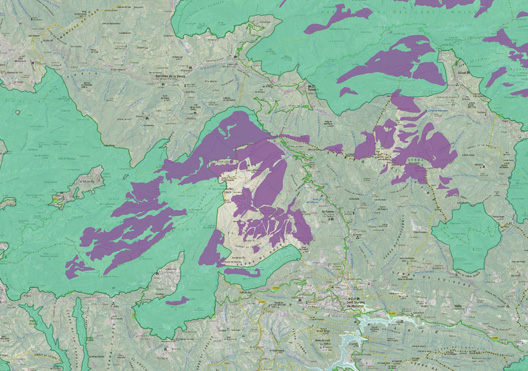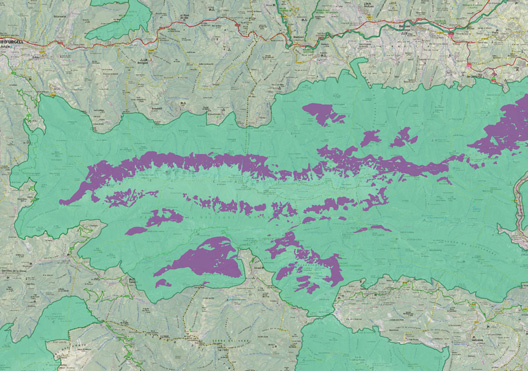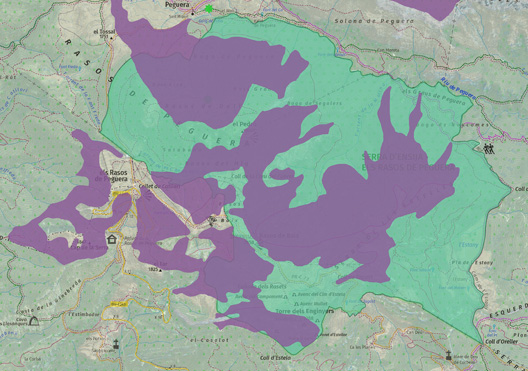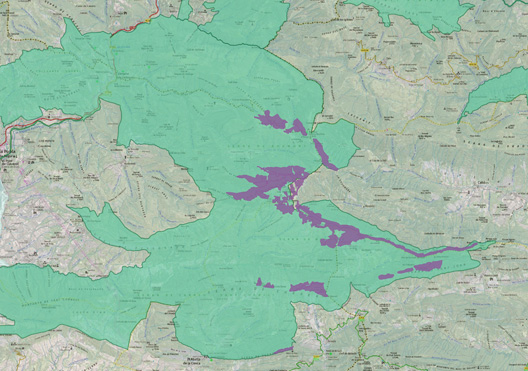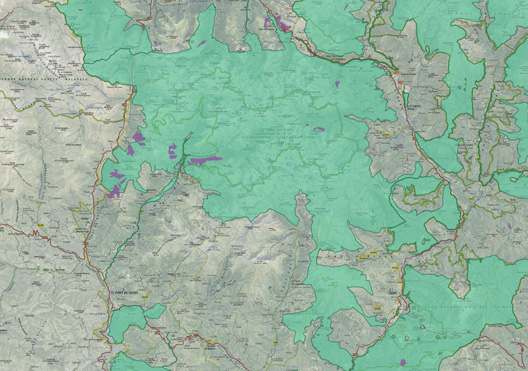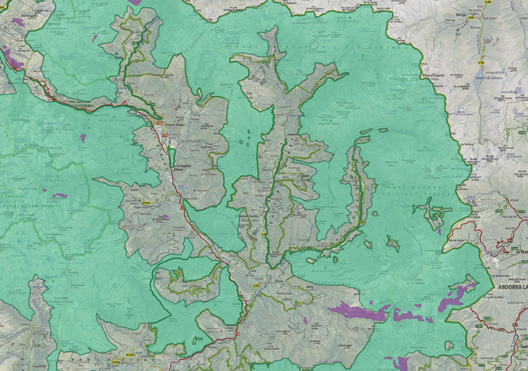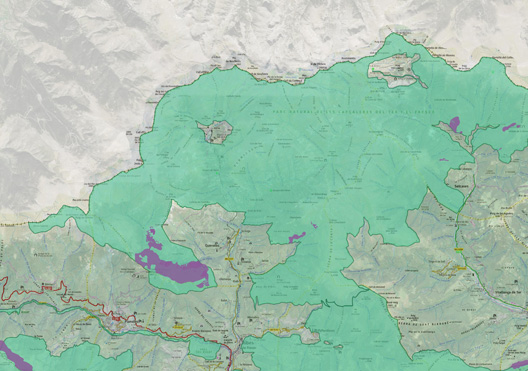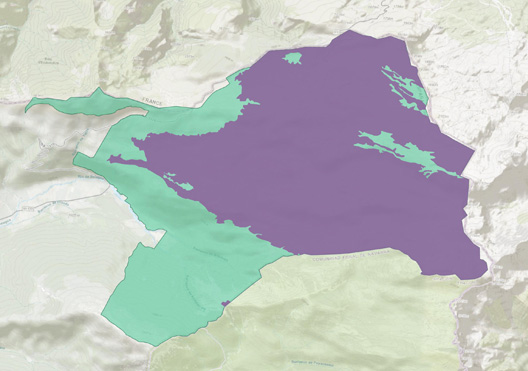Scope
SAC ES00000018
This is the best representation of the Catalan calcareous Pre-Pyrenees. It has its highest point at the summit of Vulturó (2649m). The biogeographical interest of this area should be highlighted, as it is a good representative of the transition from Mediterranean-type habitats to subalpine and alpine habitats. The former are mainly located in the valley bottoms, generating unique microenvironments. The area is characterized by its abrupt calcareous reliefs, among which the karstic modeling stands out, with a clear asymmetry between its slopes. It is important to highlight the great diversity of landscapes in this territory, with a typical altitudinal zonation ranging from the basal stratum with Mediterranean holm oak groves to the alpine meadows of the culminating levels of Festuca airoides, to the different forest formations of sub-Mediterranean character (Quercus pubescens domain), Eurosiberian beech forests, boreal forests of Scots pine (Pinus sylvestris) and spruce (Abies alba) and, finally, subalpine forests of mountain pine. Some endemic or very rare species of flora not found elsewhere in Catalonia are present, such as Xatardia scabra, Woodsia glabela, Potentilla nivalis, Adonis pyrenaica, and Campanula jaubertiana. Another botanical element worth highlighting is Cypripedium calceolus, or lady’s slipper, an orchid of great botanical and social interest. The special biogeographical conditions of the area also determine the presence of a great variety of animal species, including some at the border of their distribution range, such as the chamois (Rupicapra pyrenaica), the capercaillie (Tetrao urogallus), the black woodpecker (Dryocopus martius), or the boreal owl (Aegolius funereus). Among the invertebrates, endemic or rare species of arachnids (Troglohyphantes orpheus) and heteroptera (Loricula pselafiformis) stand out.
SAC ES5130010
In this area, a large part of the typical landscapes of the central Pre-Pyrenees are represented in its southern limit, with some Pyrenean elements that have penetrated up to the culminating zones of this territory (Cap del Boumort, 2,076 m). On its southern slope there is a greater representation of Mediterranean and sub-Mediterranean landscapes. It constitutes the southern limit of distribution for some elements of the high mountain flora and fauna. The pine forests of mountain pine (Pinus nigra ssp. salzmanii) and Scots pine occupy a large area and are occasionally accompanied by undergrowth of bearberry (Arctostaphilos uva-ursii), among other species (Juniperus communis, Cotoneaster integerrimus, etc.). Only in the highest areas is the presence of subalpine forests dominated by mountain pine, often with Sesleria caerulea, in its only known locality in the central Pre-Pyrenees. Its location in a transition zone between the Mediterranean and Alpine regions, provides the area with a particularly diverse flora, very rich in rare species, being one of the southern limits of distribution of alpine and Pyrenean orophytes (Narcissus alpestris, Pulsatilla alpina, Thymelaea nivalis, Denthawia tenuifolia, Aquilegia pyrenaica, etc.). It is worth mentioning the rocky plant communities of the limestone walls of the Collegats gorge. This richness and diversity of environments also translates into a varied faunal community. It’s also worth highlighting the presence of a great variety of species of large birds of prey, being one of the areas of greatest interest for this group in the Pyrenees. Also noteworthy is the presence of many species typical of high mountains, which often find their southern limit of distribution, among which are the capercaillie, the little owl, the ptarmigan (Perdix perdix ssp. hispaniensis), the black woodpecker or the wallcreeper (Tichodroma muraria).
SAC ES0000022
One of the best representatives of the natural systems of the axial granitic Pyrenees. Quaternary reliefs on granite and slate form abrupt, spectacular, and unique reliefs, due to glacial and peri-glacial modeling (cliffs, gorges, lakes, glacial cirques, ponds, U-shaped valleys, etc.). In addition to the granite, in the northeastern and southwestern sector there are slates, schists and limestones. In the southeastern sector there are Devonian calcareous materials, mainly silicic. This place shows a varied and interesting lacustrine and fluvial system. The vegetation forms a mosaic of a great diversity of Pyrenean plant communities, depending on several environmental gradients such as altitude (up to 3029 meters at the Comaloforno peak), substrate, and humidity. Although forests occupy a reduced proportion of the central zone of the SAC (which coincides with the Aigüestortes National Park), dominated by grasslands and rocky areas, their representation increases in the peripheral areas, where coniferous forests (especially Scots pine, spruce, and mountain pine) of the montane and subalpine levels predominate. Pioneer birch forests, mixed deciduous stands, and other mixed formations such as beech-fir are also represented.
The flora is very rich, with uncommon or rare plants in the Pyrenees, such as Pinguicula alpina, Alchemilla pentaphyllea, Campanula jaubertiana, or Saxifraga androsacea. The area also contains a great cryptogamic and bryophyte richness with several arctic-alpine species unique to the Iberian Peninsula and some tertiary relics, as well as high mountain wetlands and peat bogs, with species of great interest on a Pyrenean scale, such as Drosera anglica, Utricularia minor, or Scorpidium scorpioides. In general, the fauna is typical of the high Pyrenean mountains, but Mediterranean fauna penetrates to the lower areas. Some examples of the most representative fauna are the chamois, capercaillie, Pyrenean desman (Galemys pyrenaicus) and the important population of stoats (Mustela erminea), among many others. The meadows located in some perimeter areas of this space are areas of high interest for the feeding of scavenger birds of prey. Of the invertebrate fauna, the presence of relict mollusk species in the Pyrenees, such as Pisidium hibernicum and Discus ruderatus, or Phenacolimax annularis, which is not found elsewhere in the Pyrenees, stands out. There are rare species of Coleoptera such as Carabus rutilans ssp. opulentus, heteropterans with several species that have their southern limit in this area (Arctocorisa carinata, Platycranus longicornis), and Lepidoptera with singular species such as Thera stragulata and Heliothea discoidaria.
SAC ES130003
It is one of the best representatives of the Catalan High Silicic Pyrenees, including its highest point (Pica d’Estats, 3143m). The vegetation landscape is characterized by its great diversity and includes all the vegetation units typical of the altitudinal zonation of the Central Pyrenees. In its northwest extreme, magnificent representations of the subalpine landscape, the siliceous mountain pine forests, and the rhododendron scrubs (Rhododendron ferrugineum) stand out. The alpine stratum, very diverse, includes acidophilic and calcareous meadows and pastures, rock communities, and others. In the lower areas of the northeastern sector there are forests with marked Mediterranean character, such as the kermes oak forests (Quercus ilex ssp. rotundifolia), an example of Mediterranean influence on the high valleys of the Pyrenees. The oak groves with pubescent oak (Quercus humilis) and Scots pine forests are also well represented. Although the riparian forests are rather reduced, in some fluvial stretches of the southern zone there are interesting communities of serge (Salix elaeagnos) or some well-preserved stretches of alder groves (Alnus glutinosa). Together with the Aigüestortes area, it is the best representative of the fauna of the Central Pyrenees, characterized by the presence of numerous alpine species such as the chamois, the stoat, the Pyrenean desman, or the ptarmigan (Lagopus mutus). However, the importance of the area is highlighted by the populations of two emblematic species of the Pyrenees, such as the capercaillie and the brown bear (Ursus arctos).
SAC ES5120002
This place is a sample of the glacial and periglacial geomorphology of the eastern Pyrenees and allows the observation of highly complex topographic forms such as cirques and snowdrifts. The headwaters of the Ter and Freser rivers are made up of phyllites and sandstones interspersed with carbonates -marbles- and Hercynian sandstones. At the geological level, the Núria-Carançà-Canigó gneiss stands out. The strong altitudinal gradient makes it possible to find a great diversity of plant communities: the montane floor is dominated by mesoxerophyllous deciduous forests, while the subalpine floor is dominated by conifers, including mountain pine forests at their easternmost distribution limit. Grasslands dominated by Festuca airoides or Nardus sp. characterize the alpine stratum. Its geographical location and richness of environments allows to find among the vegetation some endemic and rare species in the Pyrenees (Papaver rhaeticum, Viola diversifolia, Senecio leucophyllus, etc.) as well as numerous fungi, lichens, and bryophytes. Also noteworthy are the communities typical of rocky outcrops, alpine scrublands, mountain wetlands, or megaforbia communities, for example with Adenostyles alliariae. Among the fauna, it stands out for being the easternmost limit of distribution of many species of the high Pyrenean mountains, such as the rock ptarmigan, the capercaillie or the Pyrenean desman. The headwaters of the Ter and Freser rivers are populated by high mountain fauna and mountain communities different from those of other Pyrenean rivers. The invertebrate fauna also includes numerous endemic, rare and vulnerable species of mollusks (Arianta xatarti), arachnids, lepidoptera and heteroptera (Epirrhoe tristata, Boloria napaea, Plagiognathus abrotani), myriapods (Lithobius ambulotentus) and coleoptera (Geotrechus puigmalensis).
SAC ES0000123
From the habitat point of view, Larra-Aztaparreta is especially important because it harbors the only representation in Navarra of certain habitats of the Directive that are typically alpine or subalpine and of some subtypes characteristic of these floors. In the Larra-Aztaparreta SCI, a total of 27 natural habitat subtypes have been identified, grouped into beech and pine forests (42%), scrubland (3.97%), pastures (22.21%) and rocky vegetation (chasmophytic), tundra and riverbeds (29.28%). Almost the entire surface of Larra-Aztaparreta is occupied by natural or semi-natural habitats (only 11.33 ha of crops), most of which are considered habitats of the Directive, 14 of Community interest (23 subtypes) and 2 of priority interest (4 subtypes). Among the habitats of the Directive that only appear in Larra-Aztaparreta, we find the Festuca eskia pastures (Directive 92/43/EEC Code (CodUE) 6140), together with the mountain pine forest (CodUE 9430*, habitat of priority interest), which with its two subtypes (pine forest with rhododendron and pine forest with bearberry), maintains practically 100% of its surface in Larra-Aztaparreta and therefore this SCI is a priority area for its conservation. Larra-Aztaparreta is also the most representative area for the two subtypes of subalpine scrub (CodUE 4060), a habitat that also occurs, although it occupies very small areas elsewhere; however, the subalpine scrub subtype of Vaccinium uliginosum susp. microphyllum is found only in Larra-Aztaparreta. Among the species linked to forests, Sorbus hybrida Vulnerable in the IUCN Red List of Spanish Vascular Plants and Buxbaumia viridis, which is a rare specialist moss of decaying fir wood, included in Annex II of the Habitats Directive, stand out. Among the species of interest linked to wet pastures, Dactylorhiza majalis and Swertia perennis are considered Vulnerable in the Catalogue of Threatened Flora of Navarra.
In stony pastures and mesophytic grasslands, Agrostis truncatula ssp. commista and Minuartia cerastiifolia, vulnerable, and Arctostaphylos alpinus, sensitive to Habitat Alteration, should be highlighted. Narcissus asturiensis ssp. jacetanus is included in Annex II of the Habitats Directive (92/43/EEC). Finally, among the species characteristic of crags and cliffs, Adonis pyrenaica, Buglossoides despesanii, Leucanthemum maximum, and Lathyrus vivantii are protected in the Catalogue of Threatened Flora of Navarra as Vulnerable and Sensitive to Habitat Alteration. Among the invertebrate species included in the Habitat Directive, there are records of the cerambycid Rosalia alpina, and two species of butterflies: Maculinea arion, mole ant moth (Phenagris arion) or the apollo butterfly (Parnassius apollo). In Larra-Aztaparreta we can find seven species of amphibians. Two endemic species stand out, the Pyrenean newt (Calotriton asper) and the Pyrenean frog (Rana pyrenaica). Among the rupicolous birds, necrophagous birds such as the bearded vulture (Gypaetus barbatus), Egyptian vulture (Neophron percnopterus) and griffon vulture (Gyps fulvus) stand out, rocky birds of prey such as the golden eagle (Aquila chrysaetos) and the peregrine falcon (Falco peregrinus) and other birds of interest associated with cliffs or rocky environments such as the alpine accentor (Prunella collaris), the wallcreeper, the red-billed chough (Pyrrhocorax pyrrhocorax) and the alpine sparrow (Montifringilla nivali). Among the birds linked to forest environments, the white-backed woodpecker (Dendrocopos leucotos ssp. lilfordi), the black woodpecker and the little owl stand out, which in the mountain pine forests of Larra-Aztaparreta maintains 100% of the Navarre population of this species. Even so, we could say that the most significant bird in the forests of Larra-Aztaparreta is the capercaillie, which also has its only population in Navarra in this SCI. Among the species of more open environments, in areas in mosaic of quarries with thickets of Ulex sp.Erica sp., etc. appears the ptarmigan. The alpine pastures, already above 1,900-2,000 m., are the habitat of the ptarmigan, which remains at these altitudes throughout its life cycle and only finds favorable habitats in Navarra in Larra-Aztaparreta. Although the most significant mammal is the brown bear, the chamois also stands out, which maintains its largest population in Navarra in the Larra massif, this being the western distribution limit of the species in the Pyrenees.



